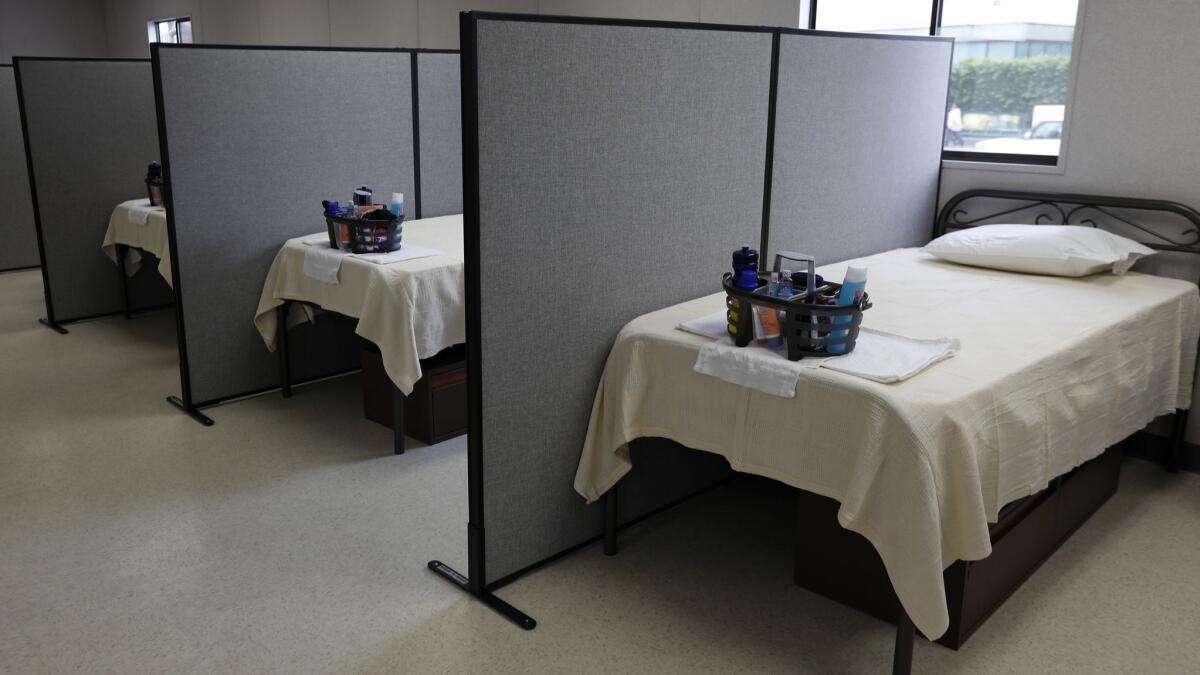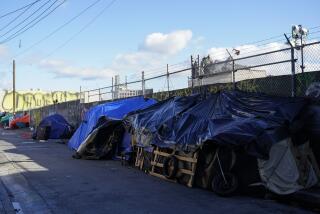Editorial: Finally, Orange County homeless people may get a place to live other than a riverbed

After months of stalling and whining, officials in Orange County have finally developed plans to provide shelter for hundreds of homeless people, many of whom were removed from encampments along the Santa Ana River Trail earlier this year. That’s a meaningful step forward; at the time the rousting began, officials had no plan for where people should go. There were not enough emergency shelters available, and the largest of them was a converted bus terminal that looked and felt more like a refugee camp.
Under pressure, Orange County cities eventually began proposing sites for more shelters, but they were then cowed by angry residents and dropped their plans. Or they proposed sites in remote, inaccessible locations — including a forest and a canyon. Spurred by several lawsuits and a federal judge who threatened to bar the city governments from enforcing their anti-camping ordinances, however, a number of cities in the county submitted some feasible plans to the court last Monday.
Anaheim is working with the Salvation Army on a roughly 200-bed project that will be constructed out of modular units. An additional 125 beds will be provided in a warehouse on private property that will be converted to a two-story shelter, offering some private bedrooms and some shared quarters. The city of Tustin will be opening a 50-bed shelter. The city of Costa Mesa is planning a shelter for a similar number. Thirteen cities in the northern part of the county are working together to open two shelters with a total of 100 to 200 beds next June.
After months of stalling and whining, officials in Orange County have finally developed plans to provide shelter for hundreds of homeless people.
The shelter that will open the soonest — and that has earned praise from the U.S. District Court judge handling the Orange County cases, David Carter — is a 200-bed facility being constructed in a large commercial building in Santa Ana. The shelter, which is expected to open before Thanksgiving, will be funded by the city of Santa Ana and run by a service organization called Mercy House. It will offer common rooms for gathering and dining, accommodations for pets, space for some belongings, a separate area for families and couples, and what officials have described as men’s and women’s “dormitories.” In fact, that just means open areas with beds, according to a Santa Ana spokesperson.
Orange County officials should keep this in mind: They can’t simply force homeless people off the streets and into shelters. The more warehouse-like the shelter, the less privacy it offers and the less safe it seems, the less homeless people will want to live in it and work with the service providers there, and thus the longer the homelessness problem will endure. The one bridge shelter in L.A. that has already opened has only 45 beds, each of them shielded to some degree by partitions. Most of the bridge shelters in L.A. will be larger than that — the proposed shelter for an expansive bus yard in Venice will have 154 beds — but the plan is to offer some semblance of sleeping cubicles, not an armory filled with beds. Officials should think about that as they design more shelters.
Enter the Fray: First takes on the news of the minute from L.A. Times Opinion »
Going forward, elected officials still must prove that they can stand firm in the face of whatever uproar may come from residents. Most of the locations of the planned shelters are undisclosed, but that won’t stay the case for long. And so far, no cities in the southern part of the county have submitted plans for shelters in their areas. That’s untenable. All parts of the county have to contribute to sheltering its homeless population.
Also, even as they continue to expand the number of emergency shelter beds, it is imperative that county officials focus on building or finding enough permanent housing for its estimated homeless population of nearly 4,800, about 2,600 of whom are unsheltered. To their credit, most of the cities proposing new shelters have said the goal will be not just to get people out of the rain (or whatever the coming winter brings) but to get them into services and ultimately into permanent housing.
But that promise of a more stable life means more than just connecting people to counselors. Orange County officials estimate that they need 2,700 units of supportive housing for homeless individuals and families. The county should take the sense of urgency it is now showing toward shelter beds and focus it on creating permanent housing as well.
Follow the Opinion section on Twitter @latimesopinion or Facebook
More to Read
A cure for the common opinion
Get thought-provoking perspectives with our weekly newsletter.
You may occasionally receive promotional content from the Los Angeles Times.






